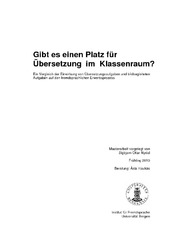| dc.contributor.author | Nydal, Sigbjørn Ottar | eng |
| dc.date.accessioned | 2010-09-10T10:01:29Z | |
| dc.date.available | 2010-09-10T10:01:29Z | |
| dc.date.issued | 2010-05-18 | eng |
| dc.date.submitted | 2010-05-18 | eng |
| dc.identifier.uri | https://hdl.handle.net/1956/4132 | |
| dc.description.abstract | In der vorliegenden Arbeit werden Übersetzungsaufgaben mit bildbegleiteten Aufgaben verglichen, um zu sehen, ob Übersetzung einen Sinn im Unterricht hat. Der Untersuchungsgegenstand ist die regelmäßigen Verben im Präsens. 30 norwegische 13-jährige DaF-Lerner nahmen an der Untersuchung teil. Im Laufe sieben Wochen wurde dreimal Daten erhoben. Diese wurde in einer Übersetzungsgruppe und eine Kontrollgruppe eingeteilt. Bei dem letzten Test haben beide Gruppen beide Aufgabentypen gelöst. Zusätzlich haben sie auch einen kurzen Aufsatz geschrieben. Die Ergebnisse der Untersuchung haben gezeigt, dass die Übersetzungsgruppe mehr oder weniger die gleichen Erfolgsquoten als die Kontrollgruppe erzielen. Außerdem sind die Raten von Transfer aus der L1 in allen Tests durchaus gering. Dies gilt für beide Gruppen bei sämtlichen Aufgabentypen. | en_US |
| dc.description.abstract | Is there a place for translation in the L2 classroom? This thesis examines the acquisition of the German present tense morphology by Norwegian 13-year-olds. Translation tasks were compared to picture verbalisation tasks (gap-tests with prompts) to see whether one of the tasks brought forth better results than the other. Furthermore the influence of the two task types on free writing was measured. 30 pupils from two schools in Norway took part in the study. 15 pupils solved translation tasks (I-group) and 15 pupils solved picture verbalisations (gap-tests with picture prompts) (K-group). After a one hour task solving and a teaching session about the German present tense morphology, Test 1 was carried out. Here the K-group outperformed the I-Group. Two weeks later the pupils completed a second test. This time the I-Group generally had higher scores than the K-Group. The third and final test one month later had a different design whereby the I-group also did picture verbalisations (gap-tests with prompts) and vice versa before both groups engaged in free production. The test provided diverging results as the I-group slightly outperformed the K-group in the two first parts of the test, yet when it came to the free production part the K-Group performed marginally better. The results thus are inconclusive as to whether one task type is more suitable than the other to enhance language learning. Other factors may contribute more to revealing differences in learner populations than the examined task types of this study. In any case translation tasks do not harm by inducing transfer in the acquisition of the German present tense morphology, as transfer rates remained low all throughout the research period. | en_US |
| dc.format.extent | 1581950 bytes | eng |
| dc.format.mimetype | application/pdf | eng |
| dc.language.iso | deu | eng |
| dc.publisher | The University of Bergen | eng |
| dc.subject | L2-Erwerb | ge |
| dc.subject | Übersetzung | ge |
| dc.subject | DaF | ge |
| dc.subject | Fremdsprachenerwerb | ge |
| dc.subject | Präsens | ge |
| dc.title | Gibt es einen Platz für Übersetzung im Klassenraum? - Ein Vergleich der Einwirkung von Übersetzungsaufgaben und bildbegleiteten Aufgaben auf den fremdsprachlichen Erwerbsprozess | ge |
| dc.type | Master thesis | |
| dc.rights.holder | Copyright the author. All rights reserved | |
| dc.description.degree | Master i Tysk | |
| dc.description.localcode | MAHF-TYS | |
| dc.description.localcode | TYS350 | |
| dc.subject.nus | 711127 | eng |
| dc.subject.nsi | VDP::Humanities: 000::Linguistics: 010::German language: 021 | |
| fs.subjectcode | TYS350 | |
